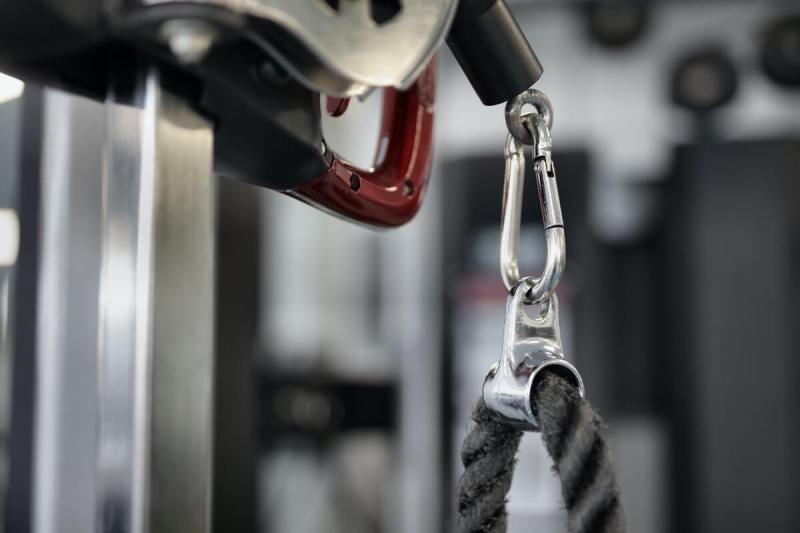A strong back looks powerful, improves your posture, and helps protect against injury. Effective isolation exercises like the cable pullover are one of the best ways to swell those back muscles. When you want to maximize your upper body muscle definition, you might want to add this movement to your training schedule. Here’s the lowdown on the cable pullover and how to perfect your form.
What is the cable pullover?

You can perform the cable pullover using a cable machine. The cable machine is made of steel and contains weights that are connected to retractable cables. This classic isolation exercise is based on shoulder extension and involves facing the cable machine, holding the cables, and pulling the cable toward your thighs. While there are other variations of the cable pullover, the version using the cable machine is the original.
What muscles does the cable pullover work?

The cable pullover is a beneficial exercise for leveling up your upper body strength.
Latissimus dorsi
You’ll primarily work the latissimus dorsi — a wide, flat muscle that runs along the length of your middle and lower back. Your lats are the widest of all muscles in your body, and they help you move your shoulders and arms and stabilize your torso. The cable pullover boosts your back power and athletic performance by engaging these major back muscles.
Triceps brachii
You’ll hit the triceps on the back of your upper arms, especially the long head. The three heads or parts of your tricep muscles work together, allowing for the extension and adduction of your arms at the shoulder joints.
Rhomboids
The rhomboid muscles in your upper back that enable you to move your upper arms while stabilizing your shoulder joints will get the work of the cable pullover. The rhomboids are made up of the rhomboid major and minor.

Pectorals
The cable pullover targets the large pectoral muscles that span most of your chest area. Your pecs are made up of two major muscle groups: the pectoralis major and the pectoralis minor. These key chest muscles assist you in flexing, adducting, and rotating your arms.
Deltoids
The deltoid muscles of your shoulders also get a workout, with emphasis on the posterior deltoid as you bring the cable in toward your body. Your delts are thick shoulder muscles categorized into three parts: the anterior or front, the lateral or side, and the posterior or rear heads.
Teres major
The cable pullover works the small teres major muscle on the underside of your upper arms. The teres major helps you move your shoulders and supports your lats.
Core
You’ll activate your obliques, abdominal muscles, and other core muscles. Engaging your core helps you maintain stability throughout the movement.
What are the benefits of the cable pullover?

The cable pullover provides plenty of benefits, including:
- Targets all major muscle groups in your upper body, including your chest, shoulders, and back.
- Improves upper body muscle definition.
- Improves upper body muscle strength and shoulder flexibility.
- Enhances your ability to perform functional activities.
- Boosts athletic performance.
- Helps with better posture.
- Lower risk of injury due to a stronger back and core.
How to do a cable pullover

The main goal with the cable pullover is to perfect your form, so you can achieve the maximum benefit and muscle activation.
How to do a cable pullover:
- Adjust the cable machine so the pulley is on the highest setting (or slightly higher than head height).
- Stand facing the cable machine and take two steps back.
- Try to keep your back straight and your feet about shoulders-distance apart.
- With a slight bend in your knees, hinge forward at your hips and grab onto the handle with an overhand grip.
- Your arms should be extended out in front of you at about face level in the starting position.
- Engage your core and keep your gaze straight ahead.
- Avoid bending your elbows and pull the cable down toward your thighs.
- Pause for a moment and squeeze your lats.
- Return the cable to the starting position with control.
- Repeat for your desired number of repetitions.
Top tips to perfect your form

Proper form lowers your risk of injury and amplifies your results.
Here are some top tips to perfect your cable pullover form:
- Keep your shoulders back and down.
- Keep your back straight and your core engaged throughout the movement.
- Focus on pulling with your lats.
- Pause for a moment at the top of the movement and squeeze your lats for the best outcome.
- Avoid bending your elbows to make sure you’re properly targeting your lats.
- Focus on form and control rather than speed and momentum.
- Avoid overstretching your arms, and make sure the pulley is in the correct position.
How to include cable pullovers in your workout routine

You can include cable pullovers on your upper body training days or when you want to specifically focus on bulking your back. Plenty of gym enthusiasts want the sculpted V-taper look and the muscle definition in the back and torso. The cable pullover is a rewarding isolation exercise that targets your lats and helps you build a broader back and bigger arms.




